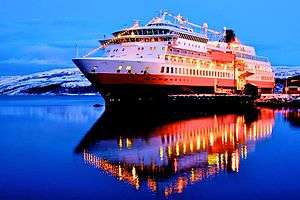MS Otto Sverdrup
MS Otto Sverdrup (call sign LDBE),[2] formerly known as MS Finnmarken, is a Norwegian coastal ship owned and operated by Hurtigruten ASA. It was built in 2002 at Kværner Kleven, Ulsteinvik, Norway, and cost around 750 million Norwegian Kroner (nok). It was part of the Hurtigruten coastal route from 2002 to 2009. In 2010 it was leased as a hotel ship in Australia. The ship returned to Norway in 2012 and is now a part of the coastal route travelling between Bergen and Kirkenes.
 MS Finnmarken in Kirkenes | |
| History | |
|---|---|
| Name: | Otto Sverdrup |
| Operator: | Hurtigruten |
| Port of registry: |
Tromsø, |
| Builder: | Kleven Verft, Ulstein, Norway [1] |
| Laid down: | 10 November 2000 [1] |
| Launched: | 15 September 2001 [1] |
| Sponsored by: | Torild Skogsholm |
| Christened: | 4 April 2002 |
| Maiden voyage: | 6 April 2002 |
| Identification: |
|
| Status: | in active service |
| General characteristics | |
| Tonnage: | 15,690 GT[1] |
| Length: | 138.5 m (454 ft 5 in) |
| Beam: | 21.5 m (70 ft 6 in) |
| Height: | 29.6 ftin |
| Draught: | 4.8 m (15 ft 9 in) |
| Decks: | 7 passenger |
| Speed: | 19 knots (35 km/h; 22 mph) |
| Capacity: | 1,000 |
MS Finnmarken is the third Hurtigruten ship with this name. Previous ships were DS Finmarken from 1912 and MS Finnmarken from 1956, which is currently part of the Hurtigruten museum in Stokmarknes, Norway.
Design and description
Finnmarken has a gross tonnage (GT) of 15,690 tons, 6,113 net tonnage (NT), and 945 tons deadweight (DWT). Loading and unloading is done with truck through a large side port on the port side. It has a car capacity of 47, 628 beds that can accommodate up to 1,000 passengers, and a top speed of 19 knots (35 km/h; 22 mph).
The ship's main engines are four-stroke diesel engines made by Wärtsilä. The engines are paired two by two. Anterior engines are 9 cylinder W9L32 with 5,630 horsepower (4,200 kW) each, and the rear are 6 cylinder W6L32 with 3,780 hp (2,820 kW) each. The stated overall performance is 18,820 hp (14,030 kW). The propulsion system is geared so that it can run in five different operating modes with both diesel-electric and conventional mechanical transmission. This allows one main engine to drive both propellers simultaneously. In addition, Finnmarken has two 1,370 hp (1,020 kW) Brunvoll FU 80 LTC 2250 thrusters at the bow and a submersible 1,650 hp (1,230 kW) Ulstein kompassthruster (azimuth pod) in the stern. Electrical power is produced by two 2500 kVA shaft generators, and a Mitsubishi S6A3-MTPA diesel emergency generator.
It has 224 ordinary cabins, 18 mini-suites, and 14 suites. The ship has eight decks that include hairdresser, internet café, solarium, fitness centre (deck 8), two bars, a library, four conference rooms, a restaurant (deck 4), two whirlpools, and a swimming pool behind the chimney (deck 7).
Since 2005, both Finnmarken and MS Midnatsol have been considered for hospital ships in the event of a war. The vessel is self-sufficient in terms of water and electricity, and waste management happens on board, which means that the ship can be at sea for long periods of time. With ten days' notice, the ship should be operational as floating field hospitals. The car deck should be made to hospitals, and will house 70 doctors and nurses. As a hospital ship, Finnmarken could accommodate 200 beds in case of war, crisis or disaster, nationally or internationally.
History
Plans for a new ship began in 1999. OVDS signed a construction contract with Kleven shipyard in Ulsteinvik with an option for two sister ships. Kleven had also built Hurtiguten's MS Nordkapp and MS Nordnorge. The ship was launched on 15 September 2001. On 4 April 2002 the ship was christened by Transportation Minister Torild Skogsholm, and it began its maiden voyage on 6 April 2002 from Bergen and visited Orkney, the Hebrides, Dublin, Southampton, Amsterdam, Hamburg, Copenhagen, Oslo, and Stavanger. Finnmarken began its regular route along the Norwegian coast on 20 April 2002.
During a storm on the night of 13 November 2004, Finnmarken suffered damage to an emergency exit hatch as a result of breakers. The ship began to take on water and the captain made the decision to return to Ålesund where the ship was repaired and continued on its way a day later.
The ship was leased for use as a hotel ship in connection with the development of the Greater Gorgon gas fields in Western Australia. The contract was for 18 months with the option of extending the lease for an additional 18 months, and was worth 135 million AUD. While in Australia the ship was painted all white and the car decks were converted into laundries and changing rooms. Finnmarken's return to Norway replaced MS Nordstjernen (built 1956). Before the ship returned to Norway, it was sent to Singapore in order to repaint and restore the ship to Norwegian standards. Finnmarken returned to Norway 16 February 2012 and began the regular route between Bergen and Kirkenes.
During the first few months of 2020, the ship underwent a 35 million USD renovation and was renamed MS Otto Sverdrup.[3][4]
References
- "Finnmarken (22853)". DNV GL Vessel Register. Det Norske Veritas. Retrieved 22 October 2014.
- "Finnmarken". marinetraffic.com. Retrieved 4 August 2020.
- "MS Otto Sverdrup". cruisemapper.com. Retrieved 4 August 2020.
- "MS Otto Sverdrup". Hurtigruten. Retrieved 4 August 2020.
External links
| Wikimedia Commons has media related to IMO 9231951. |